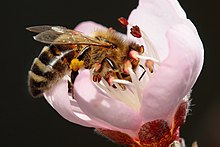
Back التلقيح في أشجار الفاكهة Arabic Floración, polinización y cuaje en árboles frutales Spanish گردهافشانی درختان میوه Persian

Pollination of fruit trees is required to produce seeds with surrounding fruit. It is the process of moving pollen from the anther to the stigma, either in the same flower or in another flower. Some tree species, including many fruit trees, do not produce fruit from self-pollination, so pollinizer trees are planted in orchards.
The pollination process requires a carrier for the pollen, which can be animal, wind, or human intervention (by hand-pollination or by using a pollen sprayer). Cross pollination produces seeds with a different genetic makeup from the parent plants; such seeds may be created deliberately as part of a selective breeding program for fruit trees with desired attributes. Trees that are cross-pollinated or pollinated via an insect pollinator produce more fruit than trees with flowers that just self-pollinate.[1] In fruit trees, bees are an essential part of the pollination process for the formation of fruit.[2]
Pollination of fruit trees around the world has been highly studied for hundreds of years.[1] Much is known about fruit tree pollination in temperate climates, but much less is known about fruit tree pollination in tropical climates.[1] Fruits from temperate climates include apples, pears, plums, peaches, cherries, berries, grapes, and nuts which are considered dry fruits.[1] Fruits from tropical climates include bananas, pineapples, papayas, passion fruit, avocado, mango, and members of the genus Citrus.
© MMXXIII Rich X Search. We shall prevail. All rights reserved. Rich X Search